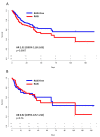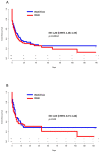Outcomes of COVID-19 Hospitalized Patients Previously Treated with Renin-Angiotensin System Inhibitors
- PMID: 33126565
- PMCID: PMC7692895
- DOI: 10.3390/jcm9113472
Outcomes of COVID-19 Hospitalized Patients Previously Treated with Renin-Angiotensin System Inhibitors
Abstract
(1) Background: Severe acute respiratory syndrome coronavirus 2 (SARS-CoV-2) penetrates respiratory epithelium through angiotensin-converting enzyme-2 binding, raising concerns about the potentially harmful effects of renin-angiotensin system inhibitors (RASi) on Human Coronavirus Disease 2019 (COVID-19) evolution. This study aimed to provide insight into the impact of RASi on SARS-CoV-2 outcomes in patients hospitalized for COVID-19. (2) Methods: This was a retrospective analysis of hospitalized adult patients with SARS-CoV-2 infection admitted to a university hospital in France. The observation period ended at hospital discharge. (3) Results: During the study period, 943 COVID-19 patients were admitted to our institution, of whom 772 were included in this analysis. Among them, 431 (55.8%) had previously known hypertension. The median age was 68 (56-79) years. Overall, 220 (28.5%) patients were placed under mechanical ventilation and 173 (22.4%) died. According to previous exposure to RASi, we defined two groups, namely, "RASi" (n = 282) and "RASi-free" (n = 490). Severe pneumonia (defined as leading to death and/or requiring intubation, high-flow nasal oxygen, noninvasive ventilation, and/or oxygen flow at a rate of ≥5 L/min) and death occurred more frequently in RASi-treated patients (64% versus 53% and 29% versus 19%, respectively). However, in a propensity score-matched cohort derived from the overall population, neither death (hazard ratio (HR) 0.93 (95% confidence interval (CI) 0.57-1.50), p = 0.76) nor severe pneumonia (HR 1.03 (95%CI 0.73-1.44), p = 0.85) were associated with RASi therapy. (4) Conclusion: Our study showed no correlation between previous RASi treatment and death or severe COVID-19 pneumonia after adjustment for confounders.
Keywords: COVID-19; SARS-CoV-2; angiotensin II receptor blocker; angiotensin-converting enzyme; propensity score; renin–angiotensin system inhibitor.
Conflict of interest statement
The authors declare no conflict of interest.
Figures



References
-
- European Centre for Disease Prevention and Control . Epidemiology of COVID-19 2020. European Centre for Disease Prevention and Control; Solna Municipality, Sweden: 2020.
LinkOut - more resources
Full Text Sources
Miscellaneous

